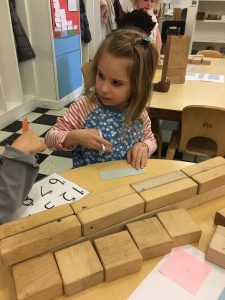Simply providing a context to mathematics does not ensure that students will find the task relevant or engaging. Students can be drawn to a problem because it relates to their lives in a real way, or there may be something interesting about a task that intrigues them and challenges them to think deeply. Mathematics that relate to other areas the student is currently studying can also provide relevance. Sometimes it’s not a matter of what specific problem is given, but how it’s posed by the teacher that piques students’ curiosity and results in deep engagement.
Where’s the Math in the MURO Wall?
Fourth Graders Participated in a Political Art Installation, and then Posed Mathematical Questions About It.
 “It’s my first political performance and I just felt I had to do it now. I wanted to show that any wall is dismantlable. We, the public, can tear down walls when society gets together. It could be a mental, physical, or political wall – the point is, it’s ephemeral.”–Bosco Sodi, Artist
“It’s my first political performance and I just felt I had to do it now. I wanted to show that any wall is dismantlable. We, the public, can tear down walls when society gets together. It could be a mental, physical, or political wall – the point is, it’s ephemeral.”–Bosco Sodi, Artist

Photos by Robert Banat: RobertBanat.com RobertBanat@gmail.com
Here Are the Range of Math Questions They Asked:
How Can We Use the Size of One Brick to Determine the Height and Length of the Wall?
How Many Inches Taller Is the Wall Height Compared to the Average Height of a 4th Grader?
How Many Bricks Are in Each Layer?
Does Each Row Have the Same Number of Bricks?
If Muro is Dismantled in 4 Hours, How Many Bricks Are Taken Down in 15 Minutes?
If There Were 20 People on Each Side of the Wall Taking Down 1 Brick Each, How Many Bricks Would Each Person Take Down?
How Many Bricks Could 8 People Remove During Each Hour If They Worked All Three Hours?
How Many Bricks In One Row?
How Many Bricks Need to be Removed Every 15 Minutes to Take Down Muro in Four Hours?
How Can Two Lines of People Dismantle 1,600 Bricks?
How Many Bricks Are Going Horizontally?
1,644 Bricks Were Dismantled in 4 Hours. How Many Bricks Were Dismantled in One Hour?
How Many Bricks Are There In Every Other Row Starting From the Top?
How Tall Are We Compared To The Muro Wall?
How Can 80 Volunteers Dismantle Muro?
Six Scenarios To Take Down Muro in Four Hours
There Are 1,644 Bricks. How Many Bricks Would Each Person Remove?































































